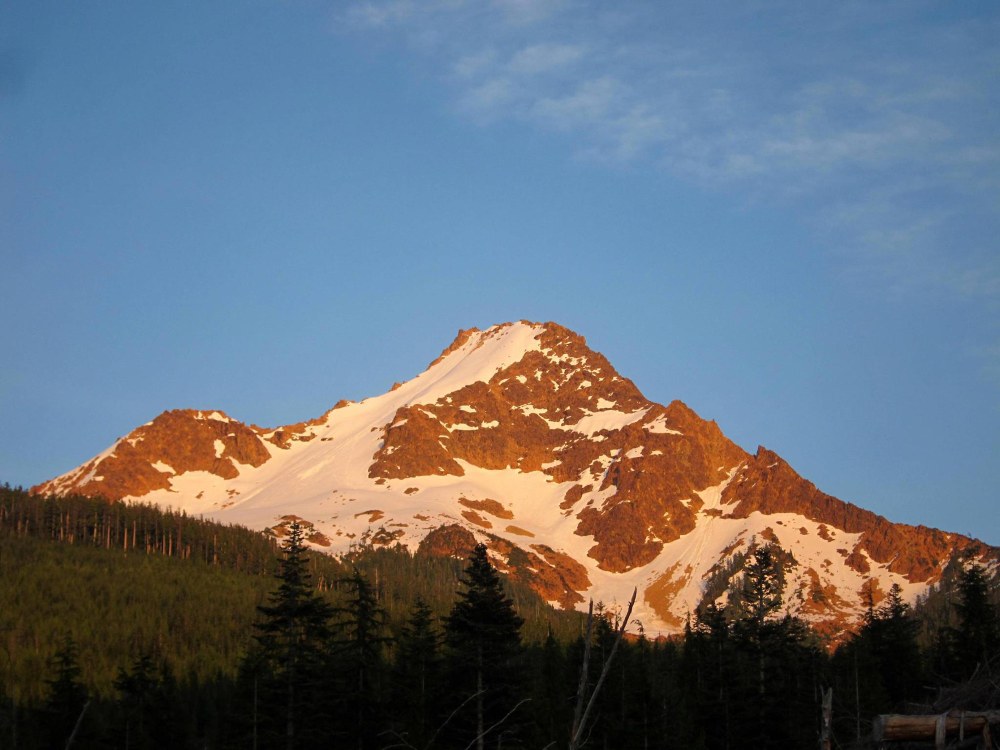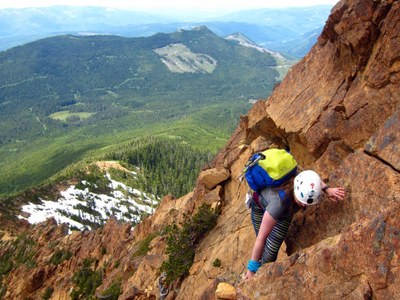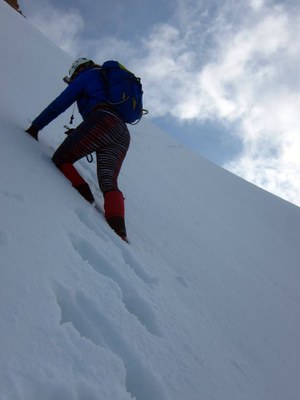
North Twin Sister, Mount Baker National Forest - June
We were so close (we think) to the summit. Darkness was still a few hours away, and we had a fleeting glimpse of hope that we’d be able to find the route and regain the ridge to the top. Passing anxious scramblers - dodging scree and loose rocks they were kicking down on each other while down-climbing a sketchy section of rock - put a damper on our spirits.
The route the other group chose to climb followed seductive cairns, but proved incorrect at a large headwall, giving an option to either go left, right, or back down. After exploring all the options, the other group decided down-climbing was their best bet.
Continuing up, we wanted to see for ourselves if there was a way to skirt around the wall. From GPS tracks of previous climbers, we knew a ridge lay beyond and could possibly be gained to achieve the summit. Looking at the headwall, we saw an exposed ramp to the left and a drop off (basically into oblivion) to the right. We chose to ascend across loose rock, peering around the corner to see if the route would "go" - it seemed to be the most direct way up the ridge. Due to loose rock and sketchy, exposed terrain, we were not eager to down climb the way we came.

As luck would have it, my climbing partner could see the ridge we were supposed to be on from where he was standing, so I traversed over to him and we started to scramble upwards towards the ridge.
We spotted slabby faces and a random cairn, propelling us back down the other side of the ridge, where we shimmied down a crack, making a few precarious moves on loose boulders before reaching what appeared could have been a path.
Hope Dashed
After stepping through some slushy snow while picking our way over the rocks, we decided to scout yet another route heading up wards again. At this point, morale was low and the was sun sinking even lower on the horizon, we decided to forgo the summit and try to find the easiest path over to the snowy slope of the North Face to begin our descent.
A few contorting moves across a scary ledge later, I felt my fingers losing grip on the tiny crimper I was holding. I was trying to find a better place for my left foot during the step-across when, palms sweaty, I yelled to my partner, “I’m gonna fall!”. He reached out and grabbed my left arm. “No you’re not!” he said, pulling me over as I half-leapt, half-slammed into him. We clung to the wall for dear life.
After this terrifying moment, the only thing I wanted to do was get down off that wall and onto terra firma.
A few deep breaths later, we looked at our options, and neither were very great. We could head upwards to gain the ridge and, if we tagged the summit, we may have been easily able to descend on the correct route. We could also continue trending downwards and across a few patches of snow towards the slope and forget about the ridge.
We chose to descend onto the snow.

In retrospect, had we been of clearer mind, we should have chosen to go up the rock instead of traversing over to the snow slope, as the consequences of a fall would have been much less catastrophic compared to the awful runout below. However, once we made up our mind that we were not going for the summit, we took all options other than a descent off the table in our subconscious thought process.
Arriving on a small platform, we pulled out our ice axes, put on our gloves and a few more warm layers, and started a self-belayed traverse down a 45-degree snow slope. Looking up, we could see the summit looming above and knew how easy it would have been to decide to head up there and bag it.
After the ordeal we just went through and a quick calculation of time it would require vs. time we had left until darkness, we decided to continue descending. We were finally down far enough to begin plunge stepping across the snowfield back towards the direction of the first ridge, where we had initially began our scrambling ascent.
A thousand feet later, we were at the bikes. About ten minutes later we were on our way down to the trailhead and biking towards the cars, and reached them just as darkness fell.
Lessons Learned
A few realizations about this epic (mis)adventure:
- Just because you see a cairn doesn’t mean you should solely rely on it to lead you in the right direction. We did research. We had maps. We had a GPS. The amount of erroneous cairns we saw along the route should have paved a pathway of many ways up the mountain, and we should have stuck to our initial plan. Instead, we threw that plan out the window when we saw the cairns, as they hold this betrothed meaning to climbers as “this is the way”, which, unfortunately, is not always the case. It really only means that someone else has been there before and built the cairn, perhaps being lost as well.
- When surrounded by others on a route, your mentality tends to mimic those around you. When we heard from the despondent scramblers climbing down, we lost some of the morale we had on reserve and picked up on their discouragement. Had we been more positive about the experience after losing sight of the cairns, or with someone who was more familiar with the route and confident that we could get to the ridge, we would have felt stronger and less unsure of ourselves at that point.
- It’s best to leave all options on the table when making a decision on which way to go. Heading to the snow slope by down-climbing seemed like the “right” thing to do when deciding to bail. What we neglected to see through our scope of narrowing judgement was that heading back up the rocks to regain the ridge instead of attempting a descent where we were would have been the lesser of the two evils, given the runout, exposure and potential for a catastrophic consequence in case of a fall. Just because you’ve decided you want to get down doesn’t mean it's necessarily the safest way to go, so it’s important to keep a clear mind, take a small break and think about consequences of your choices before you rush to make a decision.
- Understand that you can change your decision later on when you have more information. A descent is classically considered the safe and wise judgement when ascending seems more challenging or unsafe than expected, but sometimes descending (especially when it’s a different route than the one you went up) should be reconsidered when trying to find a safer return.
- The peak will always be there. It was a good decision on our part to forgo the summit, given the time of day and our dwindling morale. It was not a good decision to give up on the best route out, even if that meant ascending further up the mountain, instead of being pigeon-holed into the idea that because we were bailing, that meant we must go down. When you take a few minutes to actually look at what you’re getting yourself into, you may realize that the safer bet is the one you neglected to give much thought to.
- We had brought a rope, slings, biners and harnesses with us as we were going to attempt a traverse to South Twin Sister but didn’t expect to use them on this mountain. By mentally reserving our gear for the next peak, we ended up committing to down climbing 4th/5th class terrain that would have been potentially safer roping up on. We could have prepared to harness up in a comfortable spot and use what we brought instead of thinking, “this route doesn’t need a rope, we’ll be okay”. The situation had changed, however, and we should have looked at all the options and not discounted any of the new information the route was providing to us.
When choosing to bail off a route in the future, make sure you review ALL options and reconsider decisions once you obtain more information from your surroundings. Better safe than sorry, even if it means climbing higher to descend more safely!
All North Twin Sister photos taken by Dennis Kiilerich during the climb.
Add a comment
Log in to add comments.Thank you for writing your detailed account and analysis. Very well written. Hopefully others will use your lessons learned to prevent a mishap.
 Liana Robertshaw
Liana Robertshaw